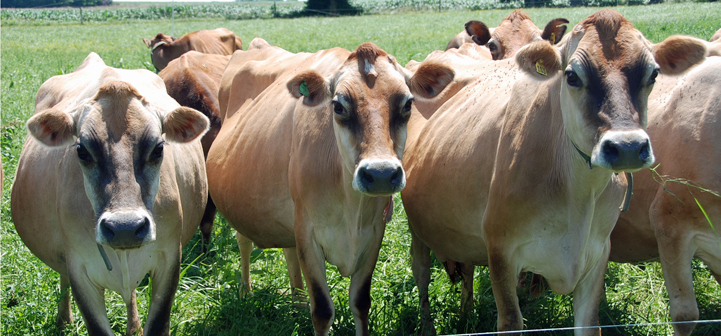 For decades dairy production systems have faced the challenge of attaining adequate fertility levels. Insufficient reproductive performance will result on reductions on the proportion of cows at their peak production period, increments in insemination costs, and delayed genetic progress. Moreover, impaired fertility is one of the most frequent reasons for culling and increased days open are associated with a greater risk of death or culling in the subsequent lactation.
For decades dairy production systems have faced the challenge of attaining adequate fertility levels. Insufficient reproductive performance will result on reductions on the proportion of cows at their peak production period, increments in insemination costs, and delayed genetic progress. Moreover, impaired fertility is one of the most frequent reasons for culling and increased days open are associated with a greater risk of death or culling in the subsequent lactation.
An historical trend for declining dairy fertility has likely resulted from high prevalence of anovulation, reduced fertilization, and embryonic survival. Contributing factors to this condition include changes in cow physiology associated with greater milk production, challenges for optimal nutritional management, housing, increased herd size, reduced estrus expression, and current genetic makeup. In addition, the level of inbreeding has increased in the Holstein population, with present average values greater than 5%.
An uneventful and timely calving is a desired trait for improved fertility of dairy cows.
Relevant to this problem, starting in the sixties, breeding programs selecting for milk production have been very successful and current trends indicate increments on milk yield per cow of 1 to 2% per year. However, some unfavorable genetic correlations between production and other traits may exist, resulting in undesirable side effects, such as a higher risk for behavioral, physiological, and immunological problems.
However, although these negative associations between production and fertility traits are probable, it is possible to select for improved milk yield and fitness traits, including fertility. This fact is evidenced by increments in reproductive performance occurring in Holsteins after the implementation of genetic evaluations for daughter pregnancy rate (DPR) in 2003. The trend for DPR indicate a partial recovery in dairy fertility, despite no apparent slowing down in the rate of increase of milk production per cow.
Genetic Selection and Improved Fertility: It’s Not That Simple
Fertility traits are multi-factorial in nature, which makes it difficult to determine the degree of involvement of genetics on reproductive outcomes. It has been established that reproductive traits are largely influenced by the environment and may be affected by multiple genes with small individual effects. Consequently, genetic progress for fertility, by way of conventional breeding strategies is hindered by low heritability, which represents the proportion of visible variation attributable to genetic differences among animals.
From the biological perspective, genetic variation affecting fertility may be directly involved in the physiology of reproductive processes. However, genetics may also determine, to some extent, the behavior of other related traits that have an impact on fertility. Among others, these comprise factors such as the ability to maintain adequate body condition and feed intake during the transition period, the potential for adequate immune responses resulting in adequate health, and the capacity to retain early pregnancy.
Some significant obstacles can be anticipated when the logistics of selection for fertility are planned. High costs of reliable data collection, the long time period required for validation, and biased phenotypes, such as non-return rates and DPR, are a few of these challenges. Adding to these limitations, the influence of factors unrelated to fertility, such as breeding policy and voluntary waiting period, is a constant difficulty for precise reproductive estimations.
A New Hope: Genomic Tools are Here to Stay
Although small heritabilities for reproductive performance traits have been reported, when more objective measures of fertility were evaluated (interval to first ovulation, anovulation, and pregnancy loss), heritabilities were moderate to high (0.15 to 0.40). For reproductive disorders, such as metritis and retained placenta, heritability estimates were close to 0.20. Notably, genetic variation is manifest when DPR is considered, as daughters of the highest and lowest sires for DPR differ by 29 days open per lactation.
With the arrival of low cost genotyping, which is the ability to read the DNA, the use of marker analysis (single nucleotide polymorphisms; SNP) in the evaluation of dairy cattle genetics has become a reality. The use of genomic analyses allows for estimation of breeding values at birth, which reduces the costs of proving bulls and increases the genetic gain because of shorter generation intervals. In addition, genotyping platforms commercially available from several companies have become widely used in research, as well as at the farm level, where genotyping of females is gaining momentum.
As with genetic evaluations, genomic selection has extended to multiple traits of economic interest, including more specific health problems. In the US, indirect health predictions are available from the Council on Dairy Cattle Breeding and recent data indicate that these traits result in genetic improvement for resistance to adverse health events. Producer-recorded health events have been successfully used to identify genetic differences between individuals regarding susceptibility to common health disorders including retained placenta, metritis, displaced abomasum, ketosis, lameness, and mastitis.
Matching Fertility and Genomics?
Specific reproductive traits that are currently evaluated by genomic analyses in the US include daughter pregnancy rate, sire calving ease, daughter calving ease, sire stillbirth rate, daughter stillbirth rate, heifer conception rate, and cow conception rate.
New research exploring genomic variation related to novel fertility traits is in progress. As a result, multiple genomic regions associated with variation in cattle reproductive traits have been mapped. More recently, genome-wide association studies (GWAS) performed with thousands of SNP markers have facilitated the resolution of associated regions and the discovery of candidate genes.
Interestingly, genomic markers have been identified for many reproductive traits including ovulation rate, pregnancy rate, DPR, non-return rate, and estrus intensity. Genetic variation has also been identified for gestation length, dystocia and stillbirth, and postpartum fertility. In addition, genomic analyses have offered the capability for locating lethal recessive genes affecting fertility outcomes. As an example, five recessive defects on fertility were recently identified by examining haplotypes that had a high population frequency but were never homozygous. These lethal effects may result in conception, gestation, and stillbirth losses.
As indicated previously, some physiological measures of fertility, such as resumption of ovarian cyclicity, have moderate heritabilities. What is interesting is that cows resuming estrous cyclicity soon after calving are more likely to show estrus and to become pregnant in a timely manner. Therefore, decomposing aggregate reproductive phenotypes into their detailed components could result into an effective tool for selection. For example, calving interval could be decomposed into several reproductive components such as the postpartum interval to commencement of estrus cyclicity, expression of estrus, conception, maintenance of pregnancy, and gestation length.
Presently, a major goal for advancing in genomic selection for fertility is the collection of high numbers of accurate fertility phenotypes associated with the corresponding genotypes, coupled to large scale evaluations of the association between direct measures of fertility. These fertility measures include uterine health, resumption of postpartum ovulation, detection of estrus, pregnancy per A.I., and maintenance of pregnancy. Collecting accurate data represents another challenge and potential strategies may include using DHI resources and data recorded within on-farm herd management software programs.
Finally, selection for traits with low heritabilities could be integrated into new reproductive technologies, such as in vitro fertilization (IVF) and embryo transplant, that allow for higher rates of genetic improvement by increasing the reproduction of superior females. It is reported this strategy could increase genetic gain by 10 to 20% compared with traditional breeding schemes.
Our Research Effort
Our team of researchers from multiple United States institutions was awarded a 5-year grant to explore genomic variation associated with reproductive traits in dairy cattle (Genomic Selection for Improved Fertility of Dairy Cows with Emphases on Cyclicity and Pregnancy; Grant no. 2013-68004-20361 from the USDA NIFA). The overall objective was to develop a fertility database with genotypes and phenotypes based on objective and direct measures of fertility in Holstein cows. The subsequent goal was to identify SNPs and haplotypes significantly associated with fertility traits by use of genome-wide analyses and to consider this information to obtain genomic-estimated breeding values that can be applied in selection of dairy cattle for improved fertility.
Consequently, our approach was to test a significant number of cows (approximately 12,000 individuals from 7 states in the USA) that were enrolled at calving and monitored weekly on farm until pregnancy confirmation. The evaluations included uterine health, metabolic status during transition, resumption of postpartum ovulation, estrus, pregnancy per AI, and pregnancy loss, under different management practices and environments.
Our initial analyses indicated that overall, 71% of the population resumed ovarian cyclicity by 50 DIM. Conception rates at first and second A.I. were 32.8% and 33.7%, respectively. Pregnancy loss between 32 and 60 days after A.I. were 10% and 8.7% for first and second A.I, respectively. Overall, 19.7% and 4% of the population was sold or died before 305 DIM.
Using this population, a reproductive index (RI) calculating the predicted probability of pregnancy at first A.I. was developed. The RI considered logistic regression models that included cow-level variables that were thought to have a genetic component (diseases, anovulation, BCS, milk yield, etc.). Interestingly, when the index from this population of cows was categorized as low, medium, and high, there was a consistent agreement between categories of the predicted RI and the measures of fertility collected from dairy cows.
By means of the developed RI, our population of cows was ranked as highly-fertile pregnant (850 cows) and a lowly-fertile non-pregnant (1,750 cows) for subsequent DNA analysis. At this point, preliminary genome-wide analyses with our high- and low-fertility subpopulations are confirming that there is potential for genomic selection in the traits of interest. We are evaluating genomic variation for dichotomous variables (uterine disease, anovulation, detection of estrus, pregnancy per AI, pregnancy loss) and for a continuous variable (predicted probability of pregnancy based on the RI, services per conception) to maximize opportunities for prediction accuracy.
Our initial analyses have estimated the heritability and the marker effects for lameness, metritis, mastitis, resumption of cyclicity, pregnancy after first A.I., and the RI. Significant markers have been associated with genes in chromosomal regions previously reported as contributing to variation in fertility and health traits in dairy cattle. In addition, causal associations among multiple traits, including retained fetal membranes, metritis, clinical endometritis, resumption of cyclicity by 50 days in milk, pregnancy after first A.I., and lameness early in lactation were investigated. Finally, selection models using significant markers are going through checking and further validation. This large scale evaluation will eventually be combined with current selection traits to further refine genomic selection of cattle by dairy producers.
Conclusions
Fertility is a key component of modern dairy production systems. However, a trend for declining dairy fertility has been evident in diverse production systems. Although fertility traits are strongly influenced by the environment, there is evidence for genotypic variation providing opportunity for selection, as suggested by a partial recovery in dairy fertility since the incorporation of daughter pregnancy rate into bull genetic evaluations. There are current efforts placed in collection of high numbers of accurate fertility phenotypes associated with the corresponding genotypes, coupled with large scale evaluations of the association between direct measures of fertility (uterine health, resumption of postpartum ovulation, detection of estrus, pregnancy per A.I., and maintenance of pregnancy) and genomic variation on dairy cows under different management practices and environments. As the cost of genotyping is decreasing, the number of animals subject to genomic evaluations is expected to continue increasing. If adequate markers and causal variants for fertility traits are identified, molecular breeding value could be estimated for each trait enabling selection to proceed population-wide.
Source: dairy-cattle.extension.org





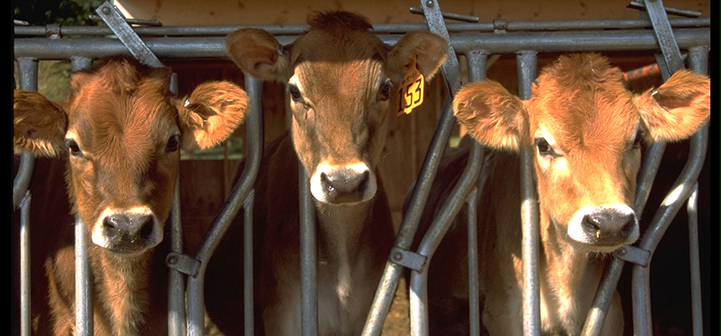 Dramatic changes have occurred in dairy sire selection practices in recent years. These changes have been facilitated by the sequencing of the bovine genome, which led to the discovery of thousands of DNA markers, known as single nucleotide polymorphisms or SNPs. The development of predicted breeding values based on marker data alone (Meuwissen et al., 2001), coupled with a reduction in the cost of genotyping, has allowed for accurate genomic selection of dairy sires by AI centers. As described by Hayes et al. (2009) genomic selection refers to selection decisions based on genomic breeding values (GEBV). Before continuing the discussion on genomic selection, however, it is important to understand traditional progeny testing. Historically, progeny testing was key to genetic improvement of dairy cattle (Sattler, 2013), via identification of the best bulls for widespread use and as sires of bulls for the next generation.
Dramatic changes have occurred in dairy sire selection practices in recent years. These changes have been facilitated by the sequencing of the bovine genome, which led to the discovery of thousands of DNA markers, known as single nucleotide polymorphisms or SNPs. The development of predicted breeding values based on marker data alone (Meuwissen et al., 2001), coupled with a reduction in the cost of genotyping, has allowed for accurate genomic selection of dairy sires by AI centers. As described by Hayes et al. (2009) genomic selection refers to selection decisions based on genomic breeding values (GEBV). Before continuing the discussion on genomic selection, however, it is important to understand traditional progeny testing. Historically, progeny testing was key to genetic improvement of dairy cattle (Sattler, 2013), via identification of the best bulls for widespread use and as sires of bulls for the next generation.



 In the coming weeks, Irish dairy farmers will be sitting down to select sires to breed the next generation of cows on their farms.
In the coming weeks, Irish dairy farmers will be sitting down to select sires to breed the next generation of cows on their farms.

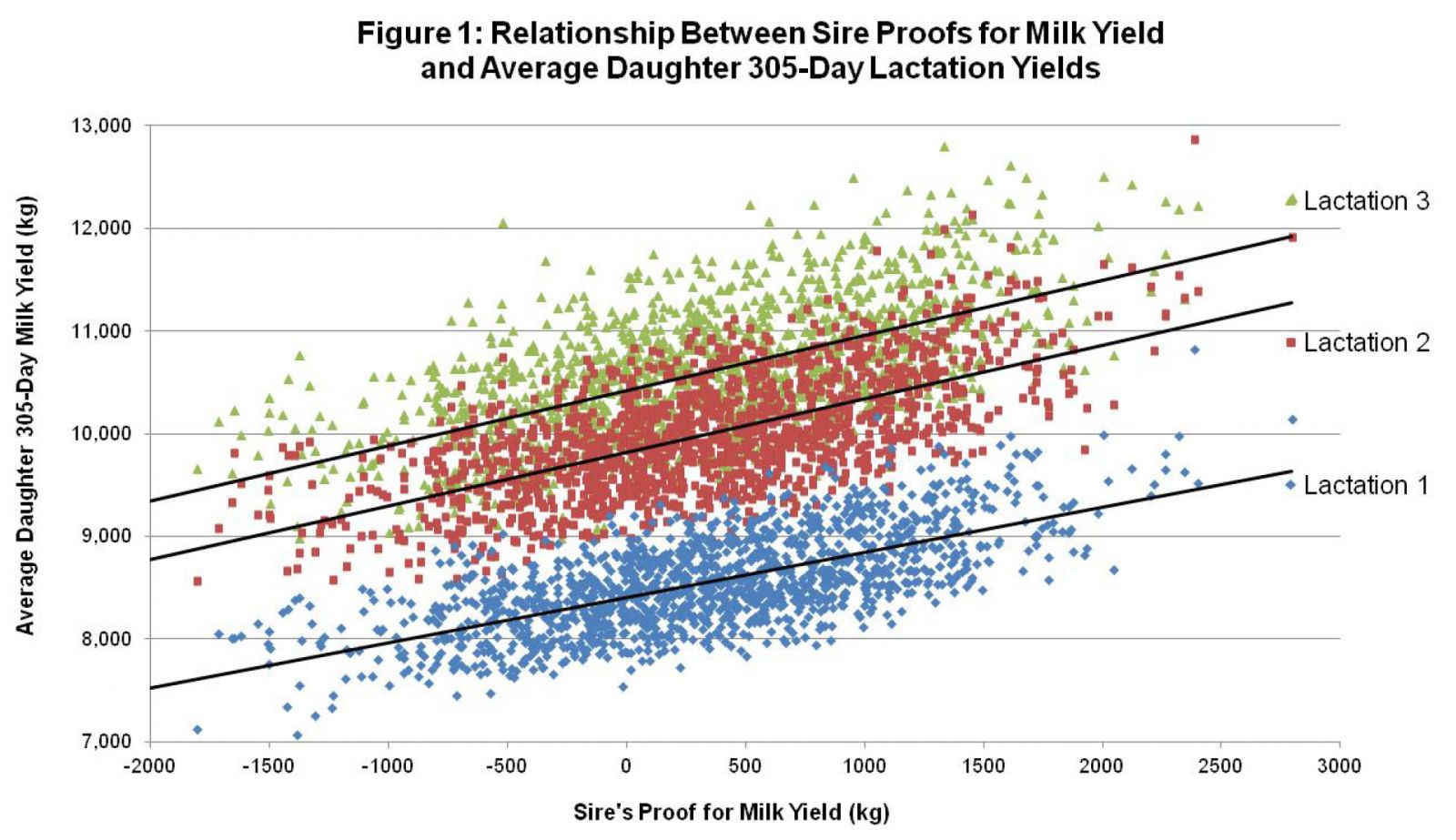
.jpg)
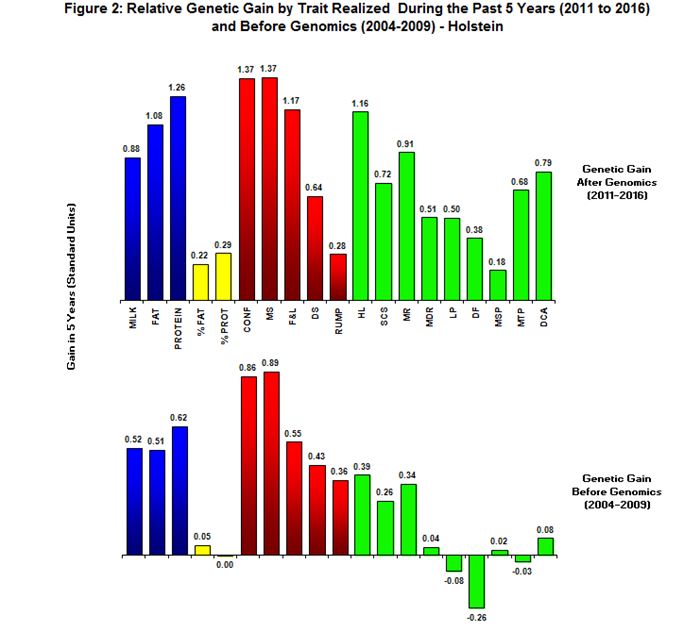

 We’re well into the genomic era. If you’re like most producers, you’re now comfortable incorporating genomic-proven bulls as part of your balanced breeding program.
We’re well into the genomic era. If you’re like most producers, you’re now comfortable incorporating genomic-proven bulls as part of your balanced breeding program.

 Graph 3. Histogram of difference in TPI from genomic release in 2013 to April 2017 daughter proof
Graph 3. Histogram of difference in TPI from genomic release in 2013 to April 2017 daughter proof Graph 4. Histogram of difference in NM$ from genomic release in 2013 to April 2017 daughter proof
Graph 4. Histogram of difference in NM$ from genomic release in 2013 to April 2017 daughter proof.JPG)
 A University of Wisconsin research professor is nearly finished with a study on genomic selection for feed efficiency in dairy cows.
A University of Wisconsin research professor is nearly finished with a study on genomic selection for feed efficiency in dairy cows. Scotland may be best known for bagpipes, but it’s the data derived from Scottish dairy cows that is music to the ears of genomic researchers.
Scotland may be best known for bagpipes, but it’s the data derived from Scottish dairy cows that is music to the ears of genomic researchers. In light of some recent election results, “giving the people what they want” isn’t always the way to go. When those people are the beneficiaries of research efforts, however, it’s not a bad idea.
In light of some recent election results, “giving the people what they want” isn’t always the way to go. When those people are the beneficiaries of research efforts, however, it’s not a bad idea..jpg)
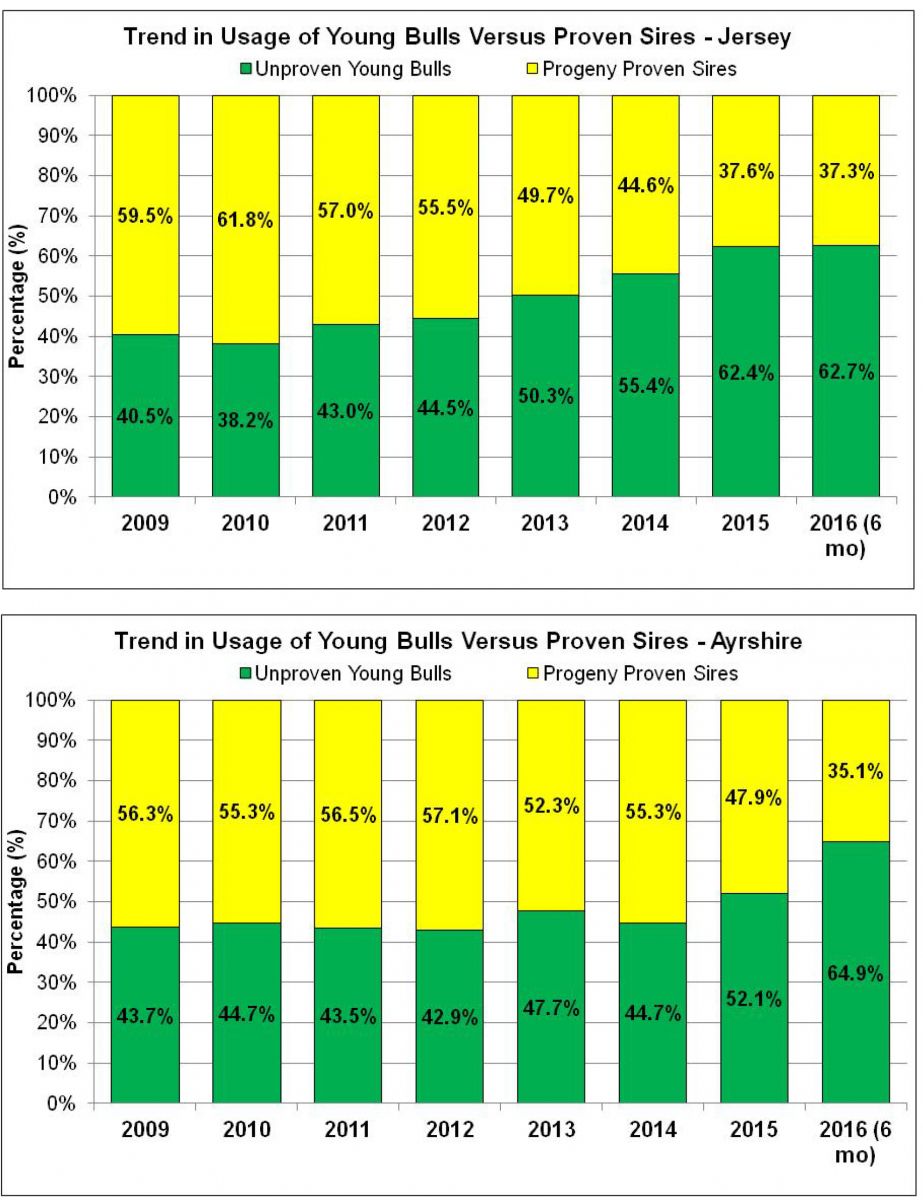
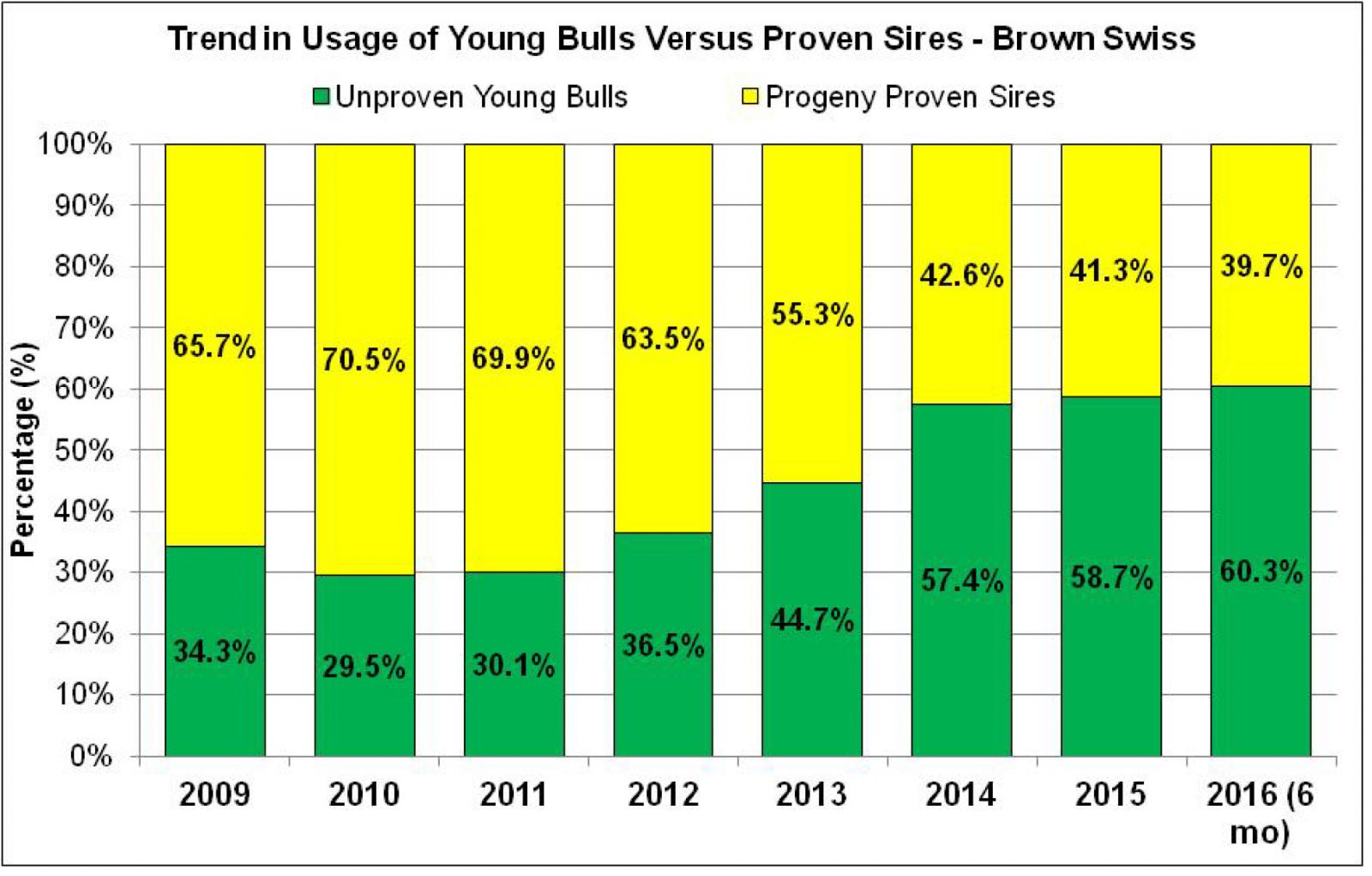

 Advances in genomic testing create new opportunities for commercial dairy producers to have more control over their herds’ profit potential. With an abundance of available replacement heifers, producers have the ability to replace less profitable cows with genetically superior heifers, shortening the generation interval and accelerating the genetic progress.
Advances in genomic testing create new opportunities for commercial dairy producers to have more control over their herds’ profit potential. With an abundance of available replacement heifers, producers have the ability to replace less profitable cows with genetically superior heifers, shortening the generation interval and accelerating the genetic progress.![Neogen-logo[1]](https://www.thebullvine.com/wp-content/uploads/2016/03/Neogen-logo1.gif) For genomic selection, researchers look for markers or single nucleotide polymorphisms (SNPs). A SNP is a place in a chromosome where the DNA sequence can differ among individuals. SNPs are most useful when they occur close to a gene that contributes to an important trait. Most traits are controlled by many genes, making this a very complex process. Significant progress was made when a genotyping computer chip was developed that could identify more than 50,000 SNPs (50K test) on the genome.
For genomic selection, researchers look for markers or single nucleotide polymorphisms (SNPs). A SNP is a place in a chromosome where the DNA sequence can differ among individuals. SNPs are most useful when they occur close to a gene that contributes to an important trait. Most traits are controlled by many genes, making this a very complex process. Significant progress was made when a genotyping computer chip was developed that could identify more than 50,000 SNPs (50K test) on the genome. Seven years into it, genomics has become nearly as common of a term as AI. We’re now used to the genetic technology and feel confident using genomic-proven bulls as part of a balanced breeding program.
Seven years into it, genomics has become nearly as common of a term as AI. We’re now used to the genetic technology and feel confident using genomic-proven bulls as part of a balanced breeding program.





 Dr. Weigel grew up in Iowa on the family farm (Weigeline Holsteins) and graduated from Iowa State University with a Degree in Dairy Science. He received both his M.S. and PhD from Virginia Tech, with his dissertation focusing on the prediction of genetic merit for lifetime profitability in Holsteins. Before joining the R&D group of Zoetis (formerly Pfizer Animal Health) in 1995, Dr. Weigel served as a post-doctoral fellow at the University of Guelph working on the implementation of Multiple Across Country Evaluations (MACE) for conformation traits of Holstein sires. Dr. Weigel’s current role with Zoetis is in Outcomes Research and he remains active as a breeder of Registered Holsteins.
Dr. Weigel grew up in Iowa on the family farm (Weigeline Holsteins) and graduated from Iowa State University with a Degree in Dairy Science. He received both his M.S. and PhD from Virginia Tech, with his dissertation focusing on the prediction of genetic merit for lifetime profitability in Holsteins. Before joining the R&D group of Zoetis (formerly Pfizer Animal Health) in 1995, Dr. Weigel served as a post-doctoral fellow at the University of Guelph working on the implementation of Multiple Across Country Evaluations (MACE) for conformation traits of Holstein sires. Dr. Weigel’s current role with Zoetis is in Outcomes Research and he remains active as a breeder of Registered Holsteins.![zoetis[1]](https://www.thebullvine.com/wp-content/uploads/2015/06/zoetis1.jpg)
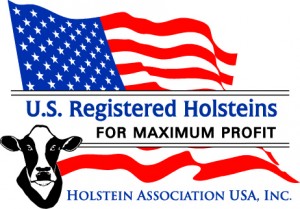
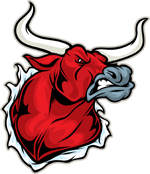
 Lindsey Worden has worked as Holstein Association USA’s Executive Director of Holstein Genetic Services since October 2013. In her role, she oversees staff responsible for maintaining the Association’s genomic and genetic testing programs and software programs such as Red Book Plus/MultiMate, as well as other performance programs such as classification and production records products, providing guidance and direction for various Association initiatives. Worden was HAUSA’s project manager for the development of the Enlight™ genetic management tool, which was developed in collaboration with Zoetis, and now oversees the team responsible for supporting the product. Prior to her current responsibilities, she served as Holstein Association USA’s communications manager for more than 6 years. Worden is a graduate of the University of Wisconsin-Madison where she studied dairy science and life science communications and was an active member of the Association of Women in Agriculture, Badger Dairy Club and the dairy judging team. She has had a lifetime of involvement in the dairy industry and Registered Holsteins growing up on her family’s dairy operations in New York and New Mexico, and in her free time still enjoys helping out on her family’s Central New York dairy and working with her cattle. Worden works out of the Holstein Association USA headquarters in scenic Brattleboro, Vermont.
Lindsey Worden has worked as Holstein Association USA’s Executive Director of Holstein Genetic Services since October 2013. In her role, she oversees staff responsible for maintaining the Association’s genomic and genetic testing programs and software programs such as Red Book Plus/MultiMate, as well as other performance programs such as classification and production records products, providing guidance and direction for various Association initiatives. Worden was HAUSA’s project manager for the development of the Enlight™ genetic management tool, which was developed in collaboration with Zoetis, and now oversees the team responsible for supporting the product. Prior to her current responsibilities, she served as Holstein Association USA’s communications manager for more than 6 years. Worden is a graduate of the University of Wisconsin-Madison where she studied dairy science and life science communications and was an active member of the Association of Women in Agriculture, Badger Dairy Club and the dairy judging team. She has had a lifetime of involvement in the dairy industry and Registered Holsteins growing up on her family’s dairy operations in New York and New Mexico, and in her free time still enjoys helping out on her family’s Central New York dairy and working with her cattle. Worden works out of the Holstein Association USA headquarters in scenic Brattleboro, Vermont. Cheryl Marti is the U.S. Marketing Manager for Dairy Genetics and Reproductive Products for Zoetis. She received her B.S. from the University of Minnesota in Animal Sciences, her M.S. in Dairy Science (Genetics emphasis) at the University of Wisconsin – Madison, and her MBA from UW-Whitewater. Cheryl worked in the AI industry at ABS Global for over 11 years in many different capacities, including management, marketing, training and technical support of the Genetic Management System (a genetic mate assignment program), and also worked in the Sire Acquisition and Research areas. She joined Pfizer Animal Health, now Zoetis, in 2005, first as a Fresh Cow Reproduction Manager in the Great Lakes states and later as a Dairy Production Specialist in WI where she often worked with large dairies on genomics, reproduction, records analysis, and transition cows until mid-2014 when she moved into her current role. Her experiences include working with herds of all sizes across the U.S. and over a dozen countries on 6 continents. Cheryl’s passion for the dairy industry and genetics began at her family’s Registered Holstein farm in Sleepy Eye, MN, where she owns some cattle, and her sister and brother-in-law own and operate their family farm of 700 acres and a 160-cow dairy called “Olmar Farms.
Cheryl Marti is the U.S. Marketing Manager for Dairy Genetics and Reproductive Products for Zoetis. She received her B.S. from the University of Minnesota in Animal Sciences, her M.S. in Dairy Science (Genetics emphasis) at the University of Wisconsin – Madison, and her MBA from UW-Whitewater. Cheryl worked in the AI industry at ABS Global for over 11 years in many different capacities, including management, marketing, training and technical support of the Genetic Management System (a genetic mate assignment program), and also worked in the Sire Acquisition and Research areas. She joined Pfizer Animal Health, now Zoetis, in 2005, first as a Fresh Cow Reproduction Manager in the Great Lakes states and later as a Dairy Production Specialist in WI where she often worked with large dairies on genomics, reproduction, records analysis, and transition cows until mid-2014 when she moved into her current role. Her experiences include working with herds of all sizes across the U.S. and over a dozen countries on 6 continents. Cheryl’s passion for the dairy industry and genetics began at her family’s Registered Holstein farm in Sleepy Eye, MN, where she owns some cattle, and her sister and brother-in-law own and operate their family farm of 700 acres and a 160-cow dairy called “Olmar Farms.
![lucky_20679[2]](https://www.thebullvine.com/wp-content/uploads/2015/06/lucky_206792-210x300.jpg) In the 1920’s and 30’s cigarette companies not only denied the health risks of smoking, they actually promoted them as a good thing, by putting up testimonials and stats about doctors who smoked. During the 1920s, Lucky Strike was the dominant cigarette brand. This brand, made by American Tobacco Company, was the first to use the image of a physician in its advertisements. “20,679 physicians say Luckies are less irritating,” its ads proclaimed. Of course many years later we are well aware of the health risks (480,000 people die prematurely each year in the US, due to smoking or being exposed to smoke). It’s flashbacks to this false advertising experience that dairy breeders are referencing when they distrust the use of genomics in dairy cattle breeding. They feel that it’s just the AI companies “forcing” genomics down their throats, in the same way that the tobacco companies “forced” smoking down the throats of millions, by using the weight of doctors’ credibility.
In the 1920’s and 30’s cigarette companies not only denied the health risks of smoking, they actually promoted them as a good thing, by putting up testimonials and stats about doctors who smoked. During the 1920s, Lucky Strike was the dominant cigarette brand. This brand, made by American Tobacco Company, was the first to use the image of a physician in its advertisements. “20,679 physicians say Luckies are less irritating,” its ads proclaimed. Of course many years later we are well aware of the health risks (480,000 people die prematurely each year in the US, due to smoking or being exposed to smoke). It’s flashbacks to this false advertising experience that dairy breeders are referencing when they distrust the use of genomics in dairy cattle breeding. They feel that it’s just the AI companies “forcing” genomics down their throats, in the same way that the tobacco companies “forced” smoking down the throats of millions, by using the weight of doctors’ credibility.![camels_doctors_whiteshirt[1]](https://www.thebullvine.com/wp-content/uploads/2015/06/camels_doctors_whiteshirt1-234x300.jpg) For a long time, physicians were the authority on health. Patients trusted their doctor’s education and expertise and, for the most part, followed their advice. When health concerns about cigarettes began to receive public attention in the 1930s, tobacco companies took preemptive action. They capitalised on people’s trust of physicians, to quell concerns about the dangers of smoking. Thus was born the use of doctors in cigarette advertisements. Executives at tobacco companies knew they had to take action to suppress the public’s fears about tobacco products.
For a long time, physicians were the authority on health. Patients trusted their doctor’s education and expertise and, for the most part, followed their advice. When health concerns about cigarettes began to receive public attention in the 1930s, tobacco companies took preemptive action. They capitalised on people’s trust of physicians, to quell concerns about the dangers of smoking. Thus was born the use of doctors in cigarette advertisements. Executives at tobacco companies knew they had to take action to suppress the public’s fears about tobacco products.![MW-AK965_cigare_20110621090115_MG[1]](https://www.thebullvine.com/wp-content/uploads/2015/06/MW-AK965_cigare_20110621090115_MG1.jpg)

 April Fools. There are just those breeders who will never accept Genomics as a tool in their breeding toolbox. For those of you who have or are still need convincing on why to use genomics in your breeding strategy we offer the following articles:
April Fools. There are just those breeders who will never accept Genomics as a tool in their breeding toolbox. For those of you who have or are still need convincing on why to use genomics in your breeding strategy we offer the following articles:



 The dairy industry needs to “wake up” to the dangers of using genomic bulls on maiden heifers, according to a breeding specialist.
The dairy industry needs to “wake up” to the dangers of using genomic bulls on maiden heifers, according to a breeding specialist.![330px-Diffusion_of_ideas.svg[1]](https://www.thebullvine.com/wp-content/uploads/2014/08/330px-Diffusion_of_ideas.svg1_.png) The reason for this has nothing to do with the merits of genomic sires versus proven sires. Rather it has to do with the historical patterns of adoption of new technologies. The theory behind this is called the Diffusion of Innovations. According to this theory, consumers differ in their readiness and willingness to adopt new technology. There are the innovators (2.5 percent of the population), the early adopters (13.5 percent), the early majority (34 percent), the late majority (34 percent), and the laggards (16 percent), who are also the people who still don’t have cell phones or who are not on Facebook.
The reason for this has nothing to do with the merits of genomic sires versus proven sires. Rather it has to do with the historical patterns of adoption of new technologies. The theory behind this is called the Diffusion of Innovations. According to this theory, consumers differ in their readiness and willingness to adopt new technology. There are the innovators (2.5 percent of the population), the early adopters (13.5 percent), the early majority (34 percent), the late majority (34 percent), and the laggards (16 percent), who are also the people who still don’t have cell phones or who are not on Facebook.
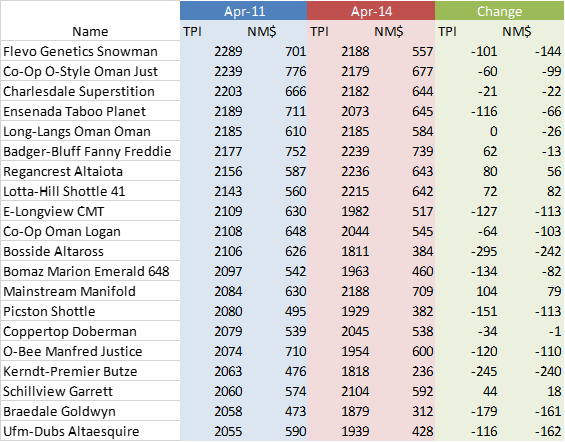
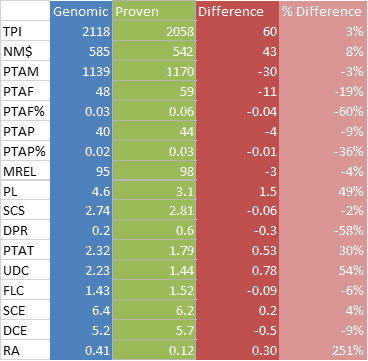
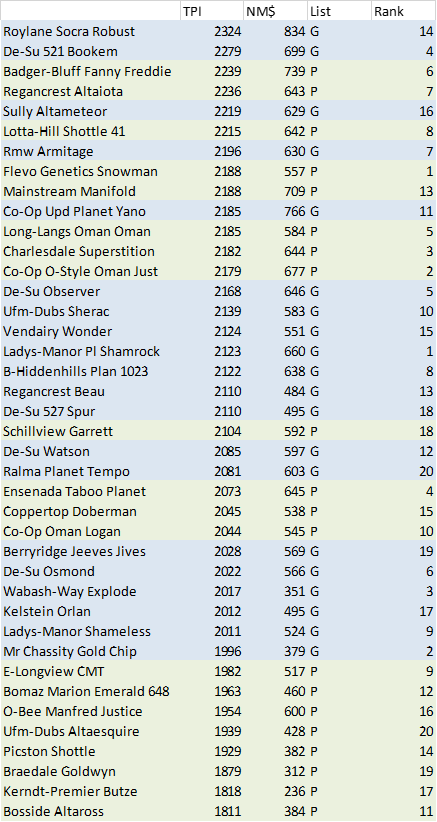
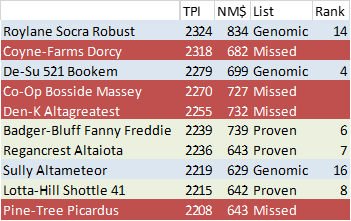
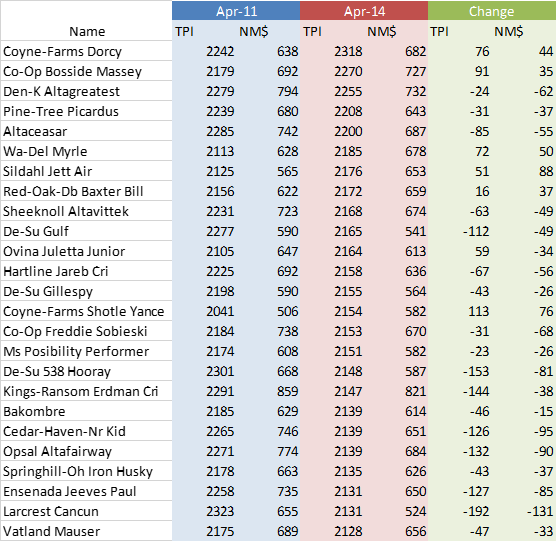
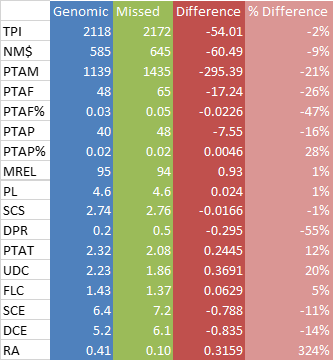
 Over the past few years, we’ve seen many examples of the benefits of genomics on the sire side. Quantifying the advantages of genomic selection on the female side has been slower, primarily due to the cautious adoption of the technology at the herd level. Of the registered Holstein heifers born in Canada in 2013, less than 5% were genotyped. On the other hand, CDN projections show that uptake could increase to surpass the 18% mark by year 2020.
Over the past few years, we’ve seen many examples of the benefits of genomics on the sire side. Quantifying the advantages of genomic selection on the female side has been slower, primarily due to the cautious adoption of the technology at the herd level. Of the registered Holstein heifers born in Canada in 2013, less than 5% were genotyped. On the other hand, CDN projections show that uptake could increase to surpass the 18% mark by year 2020.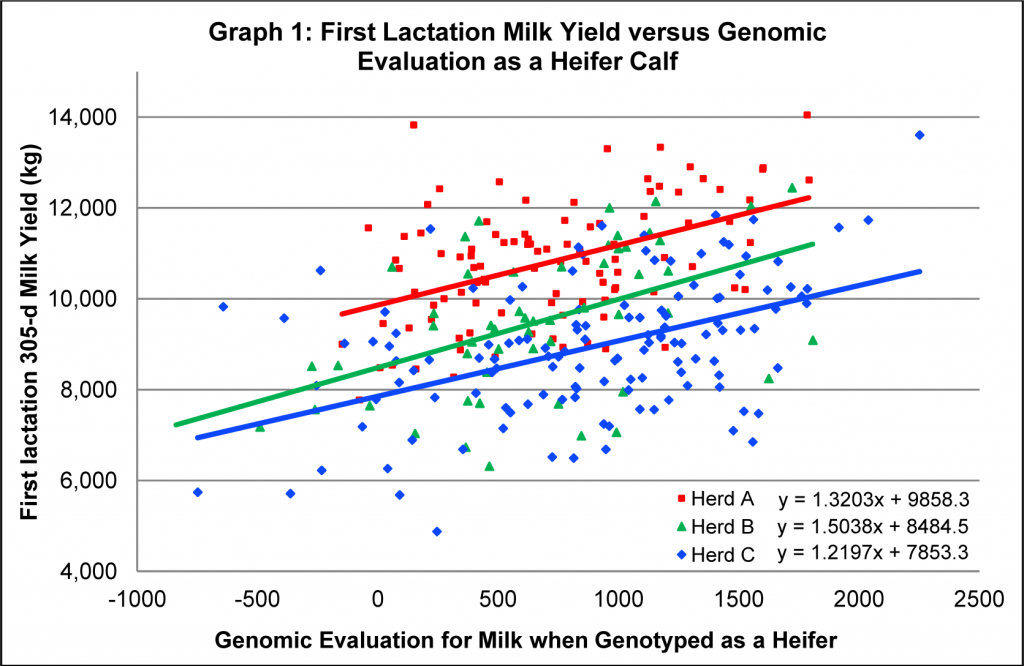

 The dairy industry has greatly evolved over the years with necessity-driven innovation. In order to be efficient in feeding a growing world, it has to.
The dairy industry has greatly evolved over the years with necessity-driven innovation. In order to be efficient in feeding a growing world, it has to.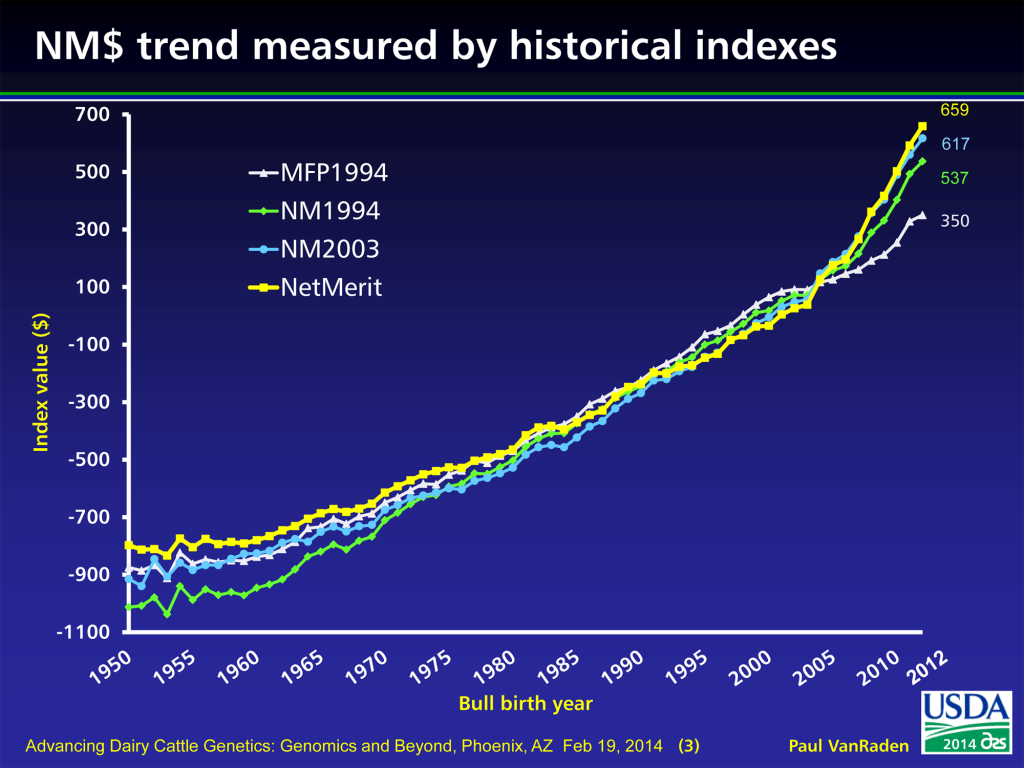
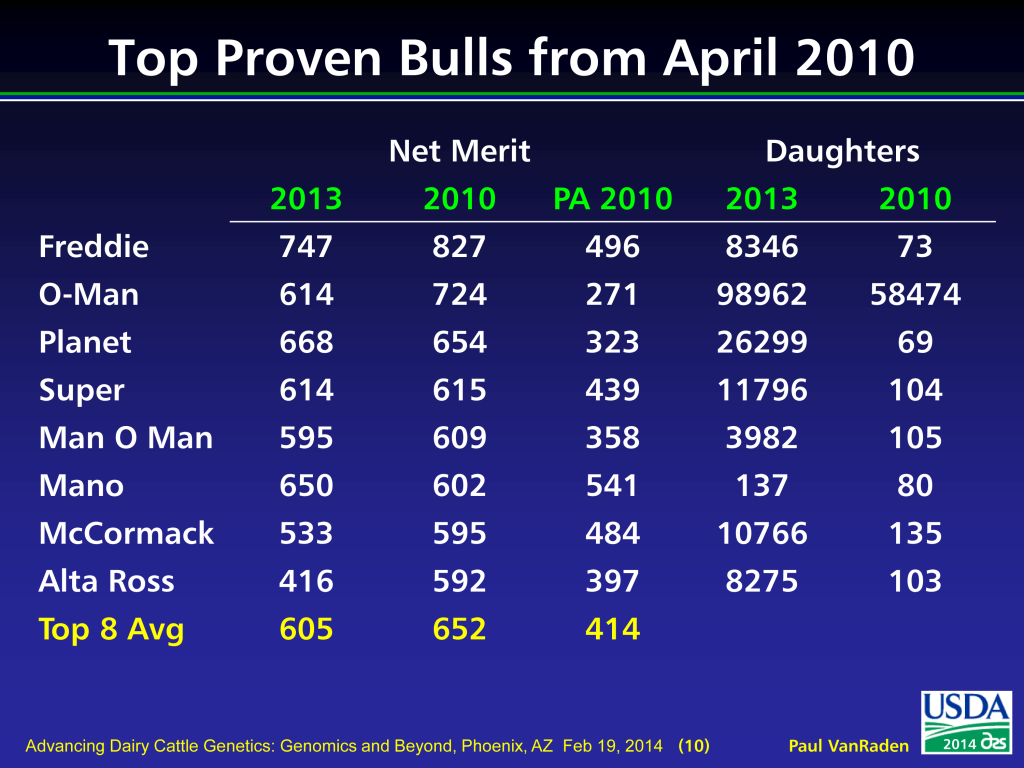
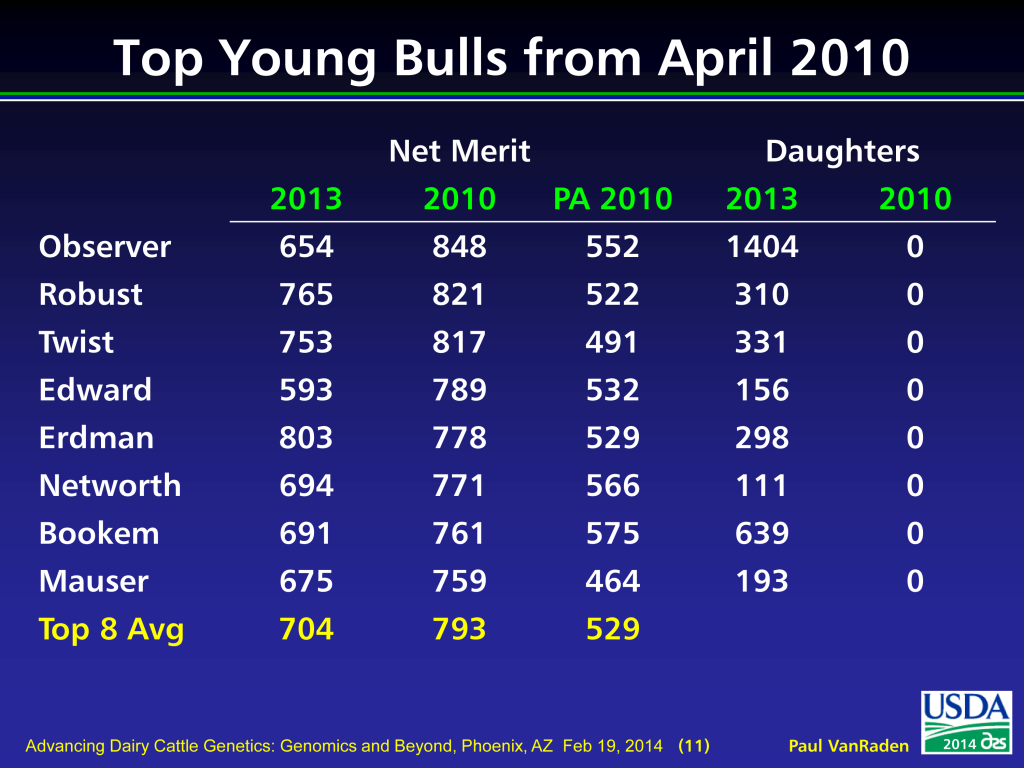


 “This cow is being stolen!” cries out Horace Backus, from the auctioneer’s box at the US National Convention sale. ‘A beautiful Jasper daughter with such a magnificent pedigree gets such a low offer – that is pure robbery!” adds Backus. Pounding his fists onto the podium, Backus has a point, since they are getting less than $5,000 for a very productive cow and moments earlier a very young calf sired by a genomic young sire sold for over $20,000. Here you have an animal already proving her profitability versus a calf that has nothing more to show for herself then a simple little test? I ask you ”Does the marketplace have it all wrong?”
“This cow is being stolen!” cries out Horace Backus, from the auctioneer’s box at the US National Convention sale. ‘A beautiful Jasper daughter with such a magnificent pedigree gets such a low offer – that is pure robbery!” adds Backus. Pounding his fists onto the podium, Backus has a point, since they are getting less than $5,000 for a very productive cow and moments earlier a very young calf sired by a genomic young sire sold for over $20,000. Here you have an animal already proving her profitability versus a calf that has nothing more to show for herself then a simple little test? I ask you ”Does the marketplace have it all wrong?”



